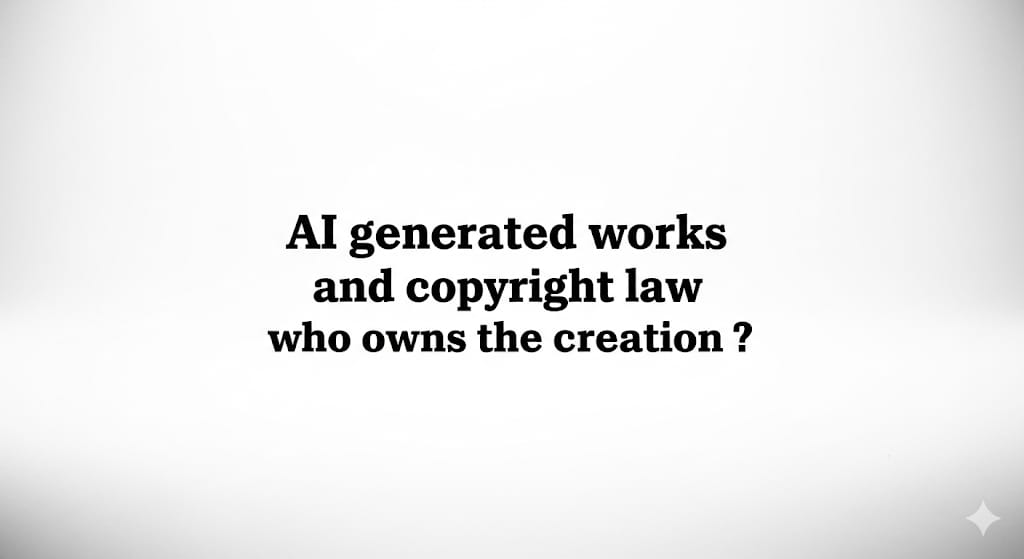Introduction
With the upsurge of sophisticated artificial intelligence (AI) tools ChatGPT, Midjourney, and many others, we are stepping into a new world where machines can literally create things on their own.
AI tools like Midjourney can build beautiful art by typing a few words.
Some AI tools can even make music on its own without the musician’s contribution to it.
Drafting templates and summarising the judgments has also become easy because of AI.
All this work was before done only by humans, but now even the machines can make it too.
This put forward a legal and moral question:
If AI creates something, can it be protected under copyright law?
And if yes, who actually owns that creation?
- Can we say the AI is the “author”?
- Or does the user who typed the prompt own it?
- Or maybe no one owns it, and it belongs to the public?
This article explores this futuristic and highly relevant issue at the intersection of technology, law, and innovation.
Understanding copyright law in India.
To make out if AI-created works can get copyright, understanding how the copyright law works in India is important.
What is protected by copyright?
India’s Copyright Act, 1957 says certain types of work can get copyright protection.
According to Section 13, it include:
(i) Literary works (like books, articles, or scripts).
(ii) Musical and dramatic works (like songs or plays).
(iii)Artistic works (like paintings, drawings, or photos).
(iv)Films and sound recordings.
Three things that are necessary for copyright are as follows;
1. The work must contain some amount of the person’s creative skill and thinking – Originality.
2. The work must be written down or recorded so others can see or hear it-Fixation.
3. The law presumes that a real person created the work – Human Authorship.
Who Owns the Work created by AI ?
Section 13 lists what types of work are protectedand section 17 says that the copyright belongs to the author (the person who created it).
Exceptions include:
If something is created by you as a part of your job, your employer owns it.
If you’re paid to create something basically commissioned work, then ownership depends on the agreement or contract.
Problem with AI:
The law doesn’t tell us what happens if a non-human like AI creates something.
Which means that there’s a legal gap – we don’t know for sure who owns the work created by AI in India.
WHAT IS AN AI – GENERATED WORK
An AI generated work is a creation without human direct authorship or intervention,it is generated autonomously by an algorithmic process.
Examples of AI-Generated Works:
(i)Visual Arts: AI like Mid journey can generate paintings or digital images from the text prompt inputs.
(ii)Music and Scripts: AI can compose music tracks and even the movie screenplay just like the original.
(iii)Computer Code: Functional software programs are generated by the AI coding assistants.
(iv)Legal Documents: AI tools draft contracts, pleadings, and other legal materials.
Such works challenge traditional definitions of creativity requiring human skill and intellect.
LEGAL VACUUM IN INDIAN COPYRIGHT LAW
At present, Indian copyright law does not specifically speaks about the AI generated works
1. According to section 2(d) of the Copyright Act:
It defines the author as the creator of a work which completely assumes human authorship, leaving AI-generated works unprotected under the statute.
2. No Explicit Recognition of AI:
In India, there is no statute or precedent which says whether AI creations can qualify as “original works” eligible for copyright.
3. Comparative Insight: UK Computer-Generated Works vs. India
In the UK according to the UK’s Copyright, Designs and Patents Act 1988 (Section 9(3))-if any work is completely made by computer without men’s skillful choices then the law still gives the copyright.( Copyright will be vested in the person who created such a program or has done such an arrangement).
Indian doesn’t have such an equivalent provision, thus there is a gap in the law when it comes to who owns the AI generated work.
KEY INTERNATIONAL CASES & DEBATES
Stephen Thaler v. USPTO (U.S.)
Thaler tried to register a patent for something which was made by AI, claiming the AI should be named as the inventor.
USPTO (U.S) dismissed by saying that only men can be an inventor.
Hence in the U.S Artificial intelligence can’t be recognised as author or inventor.
The Monkey Selfie Case (U.S.)
A macaque monkey took a photograph of itself using a photographer’s camera.
The court ruled the photo could not be copyrighted as the monkey was not a human author.
Strengthening the requirement of human authorship for copyright protection.
UK Copyright Law
As noted above, the UK law provides a clear understanding that: Copyright will be vested in the person who created such a program or has done such an arrangement.
This legal clarity is seen as pragmatic to stimulate innovation.
OWNERSHIP DILEMMAS: WHO GETS THE RIGHT
When AI makes something, it is very unclear who owns it. There can be three main possibilities:
1. The Person Who Uses the AI (Prompt Giver).
Instruction giver- means the person who types the prompt into AI.
They might say that “I made it happen, so it’s mine.”
But, just typing prompts is not the same as actually writing or drawing it yourself.
2. The Developer of the AI Tool.
The person or company that built the AI program.
They might say that “My Program made it, so I own it.”
But since the output is based on the user’s prompt, it is not always clear if they really own it.
3. No One Owns It – It Goes to the Public
If no human is directly involved in creating the content, then it may not be having any copyright. That means anyone can use it freely, no permission is required.
Problem: This can demoralize people from making or using AI tools, because they don’t get any legal right to the content which they create.
Why this is a Problem: Legal Confusion
Since the law is not clear, it is difficult for people to know who owns what.
This uncertainty makes it hard for businesses, artists, and developers to protect their work or invest in AI projects.
What’s Needed ?
A comprehensible law so that everyone like users, developers, and creators know who owns what and what rights they will be getting.
WAY FORWARD FOR INDIA
India’s copyright law does not clearly state what happens when AI makes something. Our country needs to update its laws to align with the new technology. Here’s how
1. Amend the copyright law:
Adding new rules that clearly state about AI-Generated works.
Follow examples like the UK, where the person who made the AI work(like the user )gets the copyright.
2. Decide who owns AI content
Clear rules about who gets the rights -the AI tool creator? the user? Or Both?
In some cases, the user and the AI Tool may have to share ownership.
3. Create guidelines for AI + Human Work
Sometimes Humans and AI work together (like giving prompts, editing outputs)
Rules as to decide when there’s enough human input for someone to claim authorship.
This helps protect mixed creations (Part AI, part human).
4. Protect Data & Avoid Misuse
Make sure the data used to train AI follows privacy laws.
Rules for licensing AI -Generated content-sp people don’t steal or misuse it.
CONCLUSION: LAW MUST CATCH UP WITH CODE
Al is changing the way we create things – and it’s happening very instantly, but laws are not coping up with that speed to deal with the changes.
Traditionally, Copyright law assumes that only humans can be authors or creators, but now Al is dealing with music, arts, etc. on its own without human help.
Thus the Indian copyright law does not clearly explain who owns the rights to something made by AI and whether AI – generated work can be legally protected.
As AI becomes more common in creative fields, India urgently need new rules
We need laws that:
Encourage people to innovate with AI but also protect the rights of humans creators and users.
About author
Bhavana S, a recent law graduate from BMS College of Law (B.A. LL.B), is an aspiring legal professional with a keen interest in Corporate Law, Intellectual Property Law, Real estate and Technology Law. Passionate and detail-oriented, she is dedicated to building expertise in these areas while engaging with contemporary legal developments.
REFERENCES AND RESOURCES
Maheshwari & Co. (n.d.). AI copyright law India: Ownership explained. Maheshwari & Co. https://www.maheshwariandco.com/blog/ai-copyright-law-india-ownership-explained
IIPRD. (n.d.). The nexus between artificial intelligence and copyright act. IIPRD. https://iiprd.com/exploring-the-nexus-between-artificial-intelligence-and-copyright-act
Bar and Bench. (n.d.). Intersection of intellectual property rights and AI-generated works. Bar and Bench. https://www.barandbench.com/view-point/intersection-of-intellectual-property-rights-and-ai-generated-works
Kalluri, A. (n.d.). AI and copyright: Who owns the rights to machine generated works? Lawful Legal. https://lawfullegal.in/ai-and-copyright-who-owns-the-rights-to-machine-generated-works
The Legal School. (n.d.). Artificial intelligence and copyright law in India. The Legal School. https://thelegalschool.in/blog/ai-and-copyright-law-in-india
Khurana and Khurana. (n.d.). Legalities of ownership and copyright infringement in AI-generated works. Mondaq. https://www.mondaq.com/india/copyright/1428446/legalities-of-ownership-and-copyright-infringement-in-ai-generated-works
Managing IP. (2023, August 18). Exclusive: India recognises AI as co-author of copyrighted artwork. Managing IP. https://www.managingip.com/article/2a5bqok8rjb90gcoctfkg/exclusive-india-recognises-ai-as-co-author-of-copyrighted-artwork

